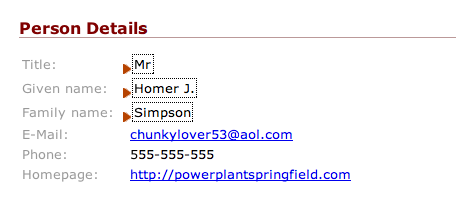Creating a Resource Type, Part 5: WYSIWYG Editing with BXE
In this section we make our person documents editable with the BXE WYSIWYG editor.
Adding the Menu Item
First, we add the BXE menu item to $MODULE_HOME/config/menu.xsp, right above the one-form editor item:
<item uc:usecase="bxe.edit" href="?"><i18n:text>With BXE</i18n:text></item>
Adding the webdavGET format
The BXE editor uses the WebDAV protocol to load the document source. To provide this functionality, we have to add the webdavGET format to our resource type declaration:
<component-instance name="person" ... <format name="webdavGET" uri="cocoon://modules/person/davget.xml"/> </component-instance>
When you re-deploy the module, make sure that cocoon.xconf is properly updated - either by deleting the file from the web application, or by adding the new line manually.
The format is served by the following pipeline in $MODULE_HOME/sitemap.xmap:
<!-- webdav GET matcher -->
<map:match pattern="davget.xml">
<map:act type="set-header">
<map:parameter name="Last-Modified" value="{date-iso8601-rfc822:{page-envelope:document-lastmodified}}" />
<map:generate src="lenya-document:{page-envelope:document-uuid}"/>
<map:transform type="uuid2url">
<map:parameter name="urls" value="absolute"/>
</map:transform>
<map:serialize type="xml"/>
</map:act>
</map:match>
Adding BXE Support to the XSLT
Now we have to add specific bxe_xpath attributes to the XHTML elements of our page so that BXE knows what can be edited. We update our stylesheet $MODULE_HOME/xslt/foaf2xhtml.xsl and add the attributes when the parameter rendertype equals edit:
<xsl:param name="rendertype"/>
...
<xsl:template name="bxeAttribute">
<xsl:param name="element"/>
<xsl:if test="$rendertype = 'edit'">
<xsl:attribute name="bxe_xpath">
/rdf:RDF/foaf:Person/foaf:<xsl:value-of select="$element"/>
</xsl:attribute>
</xsl:if>
</xsl:template>
<xsl:template match="foaf:Person">
<h2>Person Details</h2>
<table class="person">
<tr>
<th>Title:</th>
<td>
<xsl:call-template name="bxeAttribute">
<xsl:with-param name="element">title</xsl:with-param>
</xsl:call-template>
<xsl:value-of select="foaf:title"/>
</td>
</tr>
<tr>
<th>Given name:</th>
<td>
<xsl:call-template name="bxeAttribute">
<xsl:with-param name="element">givenname</xsl:with-param>
</xsl:call-template>
<xsl:value-of select="foaf:givenname"/>
</td>
</tr>
<tr>
<th>Family name:</th>
<td>
<xsl:call-template name="bxeAttribute">
<xsl:with-param name="element">family_name</xsl:with-param>
</xsl:call-template>
<xsl:value-of select="foaf:family_name"/>
</td>
</tr>
...
</xsl:template>
Now we're faced with a limitation of BXE: It is not possible to edit attributes in WYSIWYG mode. We'd have to change our XML structure to allow this. For this little tutorial, we'll just edit the element values - foaf:title, foaf:givenname, and foaf:family_name.
The rendertype parameter is passed to the stylesheet in $MODULE_HOME/sitemap.xmap:
<map:transform src="fallback://lenya/modules/person/xslt/foaf2xhtml.xsl">
<map:parameter name="rendertype" value="{request-param:rendertype}"/>
</map:transform>
Start Editing
Now you should be able to edit your person documents with BXE:



